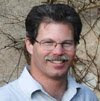Sometimes its good to get back to bare basics, if only to appreciate the conveniences we tend to take for granted.
I've just gotten back from my fourth two-week trip to Tanzania with a friend's medical team. Not being a medical type, my duties usually fall into the carpentry/infrastructure, photo-documentation, and general go-fer categories. I learned the hard way in earlier trips that taking power tools was problematic, at best. For one thing, their power is 220V (more or less), and both "dirty" and intermittent. So this time, I gave up and just took a basic set of hand tools.
As it turned out, they worked out just fine. My woodworking project turned out to be to build whatever I could in a couple of days for the microbiology lab we were helping to outfit at a small village just on the outskirts of Arusha. The wish list consisted of some storage shelves for supplies and a work table.
First duty, find some materials. This wasn't too hard a task, since there are roadside lumber dealers all over Arusha.
Luckily I had one of our driver/translators with me to help with the shopping and buying (my swahili is really, really limited). After checking out a few places we settled on a good yard that had 1x8s already rough milled, and was willing to surface them for me.
Surfacing was pretty quick, as they had a mill shop of sorts on-site. It was a little scary - not a guard in sight, and guys were cross-cutting parts on the table saw freehand. Clearly they've never heard the acronym OSHA.
Actually, I was kind of jealous. They had a couple of old industrial planer/jointer combination machines that were great. The planer and jointer shared a cutterhead, but there was no change-over that had to happen. The jointer passed stock over the top of the cutterhead in one direction and the planer passed it under the cutterhead in the other direction. Wish I could find something like that here in the US!
Anyway, materials in hand, I set out seeing how far I could get in the limited time I had. I started with the shelves first. Since the stock was now surfaced, and thus relatively clean, I tried to design a piece with as little cutting as possible (especially ripping), since my work area was really just a patch of dirty under a tree (and yes, that's the septic tank lid).
Luckily that didn't last long. This really kind of sums up the whole trip - as I was starting to get to work with the help of Jackson, one of our drivers, I was joking that I was getting too old to work on the ground. Jackson then disappeared, and about 5 minutes later returned and asked if I wanted a bench. And to my surprise a couple of guys rounded the building with a workbench lent by a local guy in the village. My "workshop" was now up and running.
And I found yet more evidence that some things are universal - this bench, while appearing to be pretty crude at first, had pretty much all the features a woodworker, from any continent, would need, such as an edge planing cradle, and various stops and hooks for bracing work. It may look crude, but it was plenty sophisticated for any woodworker's basic needs.
I tried to keep the extent of milling that I had to do to a minimum, pretty much just crosscutting parts to length. I only had to rip a few batons to keep things together. Rather than trying to get fancy with the joinery, I went with simple butt joints and screws for the most part. There's nothing like pre-drilling and driving screws by hand with a brace and bit to make you appreciate that cordless drill sitting in the shop at home. Fortunately, Jackson was more than happy to help keep things steady while I worked.
Things went pretty smoothly. Although the sight of an mzungu (swahili for foreigner, roughly) working away in back of the clinic did tend to draw some attention.
And sometimes the commuter traffic got pretty interesting....
Eventually, in about 10 hours of actual working time, I was able to complete the requested storage shelves for the lab room, and a quick-and-dirty trestle table, as well.
All in all it was yet another great experience. My thanks to Michael Eastwood and Sally Eastman for supplying the photos to document this project. And a big thank-you to the gentleman who lent me the bench, he was a life-saver.
Sunday, February 26, 2012
Subscribe to:
Post Comments (Atom)


















I think Ron and I need to accompany you and Sally on your next trip. Don't you need a woodworker/carpenter apprentice? I'm a really good gofer too. Nice photos and what a great opportunity to contribute! It doesn't get any better than marrying your skills with your social conscience. Great blog! Sandy
ReplyDelete